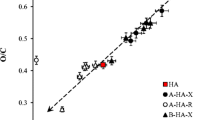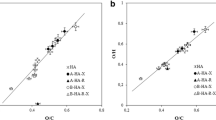Abstract
Humic acids (HAs) represent heterogeneous and polydisperse mixture of molecules that differ in their chemical structure, composition, and functional properties. Fractionation of HAs is of key importance for understanding their interactions with various organic and inorganic compounds, for studying their physiological activity, and for predicting their behavior in natural environments and agroecosystems. Existing fractionation methods are rather laborious and time consuming, which limits their application in fundamental science and industry. It is shown that fractionation of humic acids with ammonium sulfate ensures their preparative separation with respect to (a) hydrophobicity, (b) molecular size, and (c) charge dependent on the amount of functional groups. Salting out at the lowest and highest degrees of saturation with ammonium sulfate, upon which precipitation of the molecules occurs, makes it possible to separate humic acids into functionally different high-molecular-weight/hydrophobic and low-molecular-weight/hydrophilic fractions. The first fraction is characterized by a lower electrophoretic mobility than the second fraction. The weight percentage of the components coagulated at the lowest degree of salt saturation can be used as a quantitative parameter for comparing hydrophobic properties of humic acids. Salting out is recommended as a fast, simple, and cheap alternative to chromatographic methods for preparative separation of humic acids if large amounts of functionally different fractions need to be obtained.
Similar content being viewed by others
References
P. A. Albertson, Partition of Cell Particles and Macromolecules, 2nd ed. (Wiley, New York, 1971).
H. Determan, Gel Chromatography (Springer, New York, 1968).
E. Yu. Milanovskii, “Amphiphilous Components of Soil Humic Substances,” Pochvovedenie, No. 6, 706–715 (2000) [Eur. Soil Sci. 33 (6), 617–625 (2000)].
E. Yu. Milanovskii, Extended Abstract of Doctoral Dissertation in Biology (Moscow, 2006), 1–95.
E. Yu. Milanovskii, E. V. Shein, and A. A. Stepanov, “Lyophilic-Lyophobic Properties of Organic Matter and the Structure of Soil,” Pochvovedenie, No. 6, 122–126 (1993).
D. S. Orlov, Soil Humus Acids and the General Theory of Humification (Mosk. Gos. Univ., Moscow, 1990) [in Russian].
D. S. Orlov, G. I. Glebova, and T. I. Mironenkova, “Fractionation of Humus Acids by Fractional Precipitation,” Nauchn. Dokl. Vyssh. Shkoly. Biol. Nauki, No. 10, 125–129 (1976).
D. S. Orlov and L. A. Grishina, Laboratory Manual of Humus Chemistry (Mosk. Gos. Univ., Moscow, 1981) [in Russian].
L. A. Osterman, Chromatography of Proteins and Nucleic Acids (Nauka, Moscow, 1985) [in Russian].
R. K. Scopes, Protein Purification, Principles and Practice (Springer, New York, 1982).
A. A. Stepanov, “Structural Features of Amphiphilic Humic Acid Fractions from a Southern Chernozem,” Pochvovedenie, No. 8, 955–959 (2005) [Eur. Soil Sci. 38 (8), 843–847 (2005)].
P. Janos, “Separation Methods in the Chemistry of Humic Substances,” J. Chromatogr., A 983(1–3), 1–18 (2003).
A. V. Kudryavtsev, I. V. Perminova, and V. S. Petrosyan, “Size-Exclusion Chromatographic Descriptors of Humic Substances,” Anal. Chim. Acta 407(1–2), 193–202 (2000).
F. J. Stevenson, Humus Chemistry: Genesis, Composition, Reactions (Wiley, New York, 1994).
B. Theg, J. Wake, and A. Posner, “Fractional Precipitation of Soil Humic Acid by Ammonium Sulfate,” Plant Soil 29, 305–316 (1968).
A. G. Zavarzina, V. V. Demin, T. I. Nifant’eva, et al., “Extraction of Humic Acids and Their Fractions in Polyethylene Glycol-Based Aqueous Biphasic Systems,” Anal. Chim. Acta 452, 95–103 (2002).
A. G. Zavarzina, A. A. Leontievsky, L. A. Golovleva, and S. Ya. Trofimov, “Transformation of Soil Humic Acids by Blue Laccase of Panus tigrinus 8/18: An in Vitro Study,” Soil Biol. Biochem. 36(2), 359–369 (2004).
Author information
Authors and Affiliations
Corresponding author
Additional information
Original Russian Text © A.G. Zavarzina, N.G. Vanifatova, A.A. Stepanov, 2008, published in Pochvovedenie, 2008, No. 12, pp. 1466–1474.
Rights and permissions
About this article
Cite this article
Zavarzina, A.G., Vanifatova, N.G. & Stepanov, A.A. Fractionation of humic acids according to their hydrophobicity, size, and charge-dependent mobility by the salting-out method. Eurasian Soil Sc. 41, 1294–1301 (2008). https://doi.org/10.1134/S1064229308120065
Received:
Published:
Issue Date:
DOI: https://doi.org/10.1134/S1064229308120065




